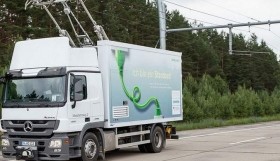Electric trucks on the Autobahn – when’s the rollout?
November 27, 2015
on
on

We already read about all-electric trucks for short-haul operations in the Port of Los Angeles but that seems so ten seconds ago compared to what is being rolled out (pun intended) as an experiment in Germany by Scania, Siemens, and the German Ministry of Transport and Traffic. On a 60 km test track north of Berlin, trucks with huge current collectors on their roofs were seen recently without so much as a puff from their exhausts. Basically hybrids of an electric locomotive and a truck, the vehicles are triple-powered: battery, overhead electricity, and diesel.
Since today’s batteries are not powerful enough to drive the heavy vehicles across large distances, electric company Siemens remembered the catenary technique that has been proven over decades and in millions of electric locomotives. But these vehicles won’t be able to run completely without the normal diesel engine. Along with truck manufacturer Scania, Siemens developed and tested a number of variants with electric and diesel motors in different configurations. Depending on the battery dimension and the performance of the electric motor the trucks can travel certain distances with electricity alone, even if no overhead wires are available. If full power is required, for instance for overtaking slower vehicles, the diesel engine is added and the pantograph is lowered to enable the truck to change to the passing lane. After overtaking is completed, the truck returns to the right lane and sensors guide the pantograph to re-establish contact with the wire.
The tests planned will show whether the technology is usable on public roads. Considered will be relatively long Autobahn stretches as well as commuting stretches, for instance between a port and a railroad station.
As usual with al technological advances, money will be the decisive factor: the catenary infrastructure is estimated to cost some 2.5 million euros for 1 km.
Since today’s batteries are not powerful enough to drive the heavy vehicles across large distances, electric company Siemens remembered the catenary technique that has been proven over decades and in millions of electric locomotives. But these vehicles won’t be able to run completely without the normal diesel engine. Along with truck manufacturer Scania, Siemens developed and tested a number of variants with electric and diesel motors in different configurations. Depending on the battery dimension and the performance of the electric motor the trucks can travel certain distances with electricity alone, even if no overhead wires are available. If full power is required, for instance for overtaking slower vehicles, the diesel engine is added and the pantograph is lowered to enable the truck to change to the passing lane. After overtaking is completed, the truck returns to the right lane and sensors guide the pantograph to re-establish contact with the wire.
The tests planned will show whether the technology is usable on public roads. Considered will be relatively long Autobahn stretches as well as commuting stretches, for instance between a port and a railroad station.
As usual with al technological advances, money will be the decisive factor: the catenary infrastructure is estimated to cost some 2.5 million euros for 1 km.
Read full article
Hide full article


Discussion (0 comments)